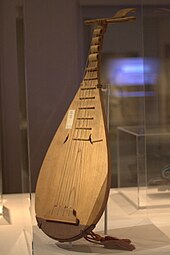Bipa
The bipa is a pear-shaped

The bipa was popular in court music until it fell out of use in the early 20th century during the Japanese Colonial period. In 1988–1989, there was the first attempt to revive the two bipa that was unsuccessful in commercialization. This revived bipa used the existing modern Chinese pipa as a basis but was modified to the Korean form, and followed Joseon style and Chinese style use of fake nails and Chinese techniques. It also reintroduced the two sound holes on the front characteristic of the two Korean bipa as well as the five strings characteristic of the hyang-bipa. The strings used are of twisted silk, rather than the metal-nylon used for the Chinese pipa. Following this recreation, there were many reinvented modern bipa.
A more faithful restoration of the two bipa is used in contemporary traditional music. In 2007, restoration by National Gugak Center of South Korea followed closely to the two original bipa from Akhak-Gwebeom [1], not made like the Chinese pipa. This recreation uses silk strings and is plucked with fake nails (formerly used bare fingers) or with a plectrum, stick. This is used for traditional music and sanjo.
Structure and playing method
Both the traditional Dang Bipa and Hyang Bipa had double crescent moons on body and had from 8 to 13 monolithic old bamboo frets (there are types up to 19 frets), especially the Hyang Bipa is painted with floral motifs on the top. The modern multi-frets Hyang Bipa is mostly influenced by the Chinese Pipa frets. In the past, two types of Bipa used twisted silk strings, but nowadays they are rarely used, but instead are made from chemical silk or polyester strings.
Hyang bipa
The Hyang bipa is a five-stringed pipa, played with a plectrum – the standard type from the
Dang bipa
The Dang bipa is a four-stringed lute, with a curved neck with 12 frets, the modern version has a wider range of three octaves. According to the Chinese character Dang (Hangul:唐, pinyin: táng) is a word referring to the Tang dynasty, which means that this type of instrument originated in China and was introduced to Korea during the Tang dynasty. During the Goryeo period (918–1392), it was used in Dangak music. However, since the Korean era, it has also been used in Hyangak.[citation needed] The name Hyangak means "village music", a form of traditional Korean court music that originated during the Three Kingdoms period (삼국시대). In the past, people have tried to restore the way to play Dang-bipa, but it seems to have failed because there are no professional musicians for this type of instrument. Currently, the Dang Bipa is restored in both shape and play. It is plucked with the mokbal plectrum (목발; 木撥) (small than bachi – plectrum of Japanese biwa) or play with gajogak like Hyang Bipa.
Notes
- ^ Professor Lee Sung-chun (1936–2003) made an attempt in 1989
External links
- Traditional Korean Music with pictures and descriptions of bipa
